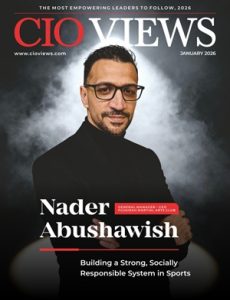The rapidly evolving world of technology needs leaders who bring not only expertise and ingenuity to the table but also a commitment to mentoring the next generation. Shawkat Bhuiyan, CTO and Chief Architect at Ideanics, is a perfect example of such a leader.
Over the years, he has driven innovation, aligned technology with business goals, and led initiatives that transformed operational efficiency and customer experience. He has built a formidable reputation for driving transformative change through the use of strategic technology. He is also dedicated to empowering young leaders, providing them with the tools and support needed to innovate and contribute meaningfully.
A true visionary, Shawkat believes in looking ahead, anticipating challenges, and finding innovative solutions to overcome them. “This forward-thinking approach has been central to my success as a leader and advisor,” he says. “It’s something I strive to instill in the teams I work with.”
As a CXO advisor at Ideanics, Shawkat guides CIOs, CTOs, and CDOs on digital transformation, M&A integration, ML/GenAI-based UX, operational efficiency, and regulatory compliance. His expertise and comprehensive experience, combined with visionary leadership, make him a sought-after advisor in the technology industry.
Introducing Seasoned Chief Architect and Technology Strategist
Shawkat is a seasoned Chief Architect and Technology Strategist with over 25 years of experience in leveraging cutting-edge technology to solve complex business challenges. His career has been shaped by a series of leadership roles that have deepened his understanding of both technology and business, laying a solid foundation for the advisory work he excels in today.
He has worked across diverse industries, including financial services, telecommunications, healthcare, and government. He began his professional journey with Atomic Energy of Canada (AECL), where he focused on enhancing operators’ experience in nuclear power plant control rooms. He then moved to Nortel to work on cross-vendor value-added sales, including pioneering video services before the advent of optical networks. “This experience taught me how to compartmentalize and solve large, complex problems,” he says.
Following Nortel, Shawkat spent a decade at IBM Global Services. There, he managed large-scale IT projects across industries such as healthcare, telecommunications, and government. He gained expertise in technology strategy and architecture and understood the importance of aligning IT initiatives with broader business objectives.
After IBM, Shawkat joined Accenture Canada as an Associate Partner, focusing on IT strategy and business process improvement. In 2010, he joined BMO Financial Group, where he spent the next decade in various leadership roles, including Head of Enterprise Architecture and Chief Architect. “My time at BMO was transformative for both the organization and myself,” Shawkat says. One of the highlights of his time at BMO was leading several major M&A initiatives.
At the core of Shawkat’s professional identity is his passion for designing and implementing technology strategies that align with business goals. “I believe in the power of a well-crafted architecture to not only support but propel an organization forward, ensuring that technology becomes a strategic asset rather than just an operational necessity,” he says.
Shawkat has built his leadership ethos on a commitment to fostering innovation, empowering teams, and constructing architectures that are both resilient and adaptable. According to him, leaders don’t just lead; they also empower others to take ownership and lead. And, his leadership style is characterized by collaboration, strategic thinking, and a relentless focus on delivering results that matter.
Shawkat believes in working closely with business leaders to translate strategic goals into comprehensive, business-focused technology roadmaps. He explains these roadmaps ensure that value, customer experience, and long-term total cost of ownership (TCO) are clearly understood and optimized, creating a cohesive strategy that drives sustainable growth and innovation.
An essential aspect of Shawkat’s architectural approach is the relentless pursuit of process simplification and operations improvement. According to him, he has consistently advocated for and implemented the transition from batch processes to event-driven, monitorable integrations, while also automating as many manual steps as possible. Additionally, he is a strong proponent of consolidating applications and systems into cohesive business capabilities across business units. He explains that this not only streamlines operations but also enhances the agility and responsiveness of the organization, ensuring that technology is a true enabler of business success.
Important Operations and Achievements
While serving in leadership roles at other companies, Shawkat led a wide range of operations, mostly centered around the design and implementation of technology strategies and architectures that drive business success.
During his tenure at Bank of Montreal (US), Shawkat managed a $600 million IT portfolio and oversaw teams of senior architects, developers, and IT professionals across North America and India. He led the bank’s digital transformation – overhauling its technology infrastructure, making it more agile, scalable, and resilient, and enabling it to respond more quickly to market changes and customer needs. This transformation reduced account opening and lending processing times from 30 days to just minutes. It was built on a composable platform architecture that not only improved efficiency but also redefined the customer experience, turning a -23% loss into a +25% gain within three years.
In addition to digital transformation, Shawkat also led several major mergers and acquisitions (M&A) initiatives, including the integration of an $11 billion bank acquisition. At the Bank, he also focused on innovation, spearheading initiatives to explore and pilot new technologies, such as machine learning, artificial intelligence, and cloud computing – always with the goal of aligning these innovations with the bank’s strategic objectives.
Roadblocks Shape Development of Resilient Leader
Shawkat’s professional journey has not been challenge-free. However, every roadblock he encountered has shaped his development as an influential Chief Architect and Technology Strategist.
One of the most significant challenges he faced was during the integration of the $11 billion bank acquisition at Bank of Montreal (US). Shawkat points out that this initiative was not just a technical challenge but also a profound cultural undertaking. They were merging teams with different organizational cultures, working methodologies, and legacy systems into a cohesive and high-performing entity. Shawkat says that the sheer scale of this integration and interdependency presented a formidable roadblock. “We were dealing with 20+ federated IT teams, processes, and customer databases that all needed to be seamlessly integrated to ensure business continuity and operational efficiency,” he adds.
To overcome this challenge, Shawkat knew that meticulous planning, coordination, and execution were critical. He also realized that it wasn’t just about technical precision; it was about empowering the teams involved. By fostering a culture of ownership and accountability, he ensured that every team member was fully engaged and committed to the success of the integration. “This experience reinforced the importance of distributed leadership in managing large-scale initiatives,” Shawkat points out.
During the digital transformation initiative, Shawkat experienced another major challenge — the resistance to change. He explains that implementing new technologies often requires a cultural shift, which can be met with resistance from teams accustomed to established ways of working. “To navigate the resistance, I placed a strong emphasis on clear communication, education, and early involvement of stakeholders,” he says.
Shawkat believes that in every transformation, from M&A to digital overhauls, the ability to embrace change is what turns uncertainty into a strategic advantage. By engaging teams early in the process and providing the necessary support and training, they were able to mitigate resistance and ensure the successful adoption of new technologies.
“These challenges have shaped me into a more resilient and adaptive leader,” Shawkat says. “They taught me the value of confronting obstacles head-on and transforming them into opportunities for growth and innovation.” His experiences have honed his ability to lead through complexity, ensuring that strategic goals are met, even in the face of significant challenges.
A Typical Day of an Influential Leader
As a CXO advisor, Shawkat guides and supports senior leaders as they navigate complex challenges and drive transformative change within their organizations. He describes his typical day as “dynamic.” It involves a mix of strategic planning, team collaboration, and problem-solving.
He begins his day early by reviewing key metrics and progress updates on ongoing projects. According to Shawkat, this keeps him informed about the status of the initiatives he is involved in and helps him identify any potential issues that need to be addressed. Following that, he holds meetings with clients to discuss their goals, challenges, and opportunities. “These meetings are crucial, as they enable me to provide tailored advice based on each client’s unique needs,” he points out.
Shawkat believes that collaboration is vital to their success. So, he spends a significant portion of his day working with his team at Ideanics. This ensures they are all aligned on the business goals, and that everyone has the support they need to excel in their roles. Shawkat’s time with his team involves brainstorming sessions to discuss new ideas and strategies. He also makes it a point to hold one-on-one meetings where he provides mentorship and guidance to the members of his team.
Additionally, Shawkat makes sure to take some time to stay up-to-date with the latest developments in technology and business. He reads industry reports, attends webinars, and participates in networking events. Shawkat says that this continuous learning is an essential aspect of his role as it enables him to provide his clients with the most current and relevant advice.
He wraps up his day by reflecting on what they have accomplished and planning for the next day. “It allows me to assess our progress, celebrate successes, and identify areas for improvement,” Shawkat says.
Personal Goals of a Business Technology Leader
As a technology leader, Shawkat intends to drive transformative change, foster innovation, and empower others to reach their full potential. He has a penchant for leveraging technology to address complex business challenges, enhance operational efficiency, and deliver exceptional customer and employee experiences. “These goals have not only guided my career but continue to shape my approach to leadership and advisory work,” Shawkat says.
A key goal of his is to assist organizations in navigating the complexities of digital transformation. He aims to work closely with them to develop and execute strategies that align with their business objectives, drive growth, and create lasting value through the integration of technologies like ML/GenAI, Cloud, and data analytics. Shawkat also wants to mentor and empower the next generation of leaders, helping them develop the skills, knowledge, and confidence to succeed.
Fostering a culture of innovation within organizations is another priority for Shawkat. He seeks to cultivate an innovative mindset by encouraging experimentation, supporting creative problem-solving, and providing the resources to turn ideas into reality. Continuous learning is also a personal goal. “Curiosity and a commitment to lifelong learning have been the driving forces behind my success,” he says.
On a broader level, Shawkat’s goal is to leave a lasting legacy of excellence, collaboration, and positive change in every organization he engages with. He wants to be remembered not just for the results he achieves but for the impact he makes on the people he works with and the organizations he serves.
Message to Aspiring Leaders
“The journey to becoming a successful leader is not a straight path,” Shawkat tells aspiring leaders. “It’s filled with challenges, uncertainties, and opportunities, and how you navigate these experiences will define your leadership and your impact on the industry.”
As change is the “only constant” in today’s business environment, Shawkat advises them to embrace it and not fear it – it’ll bring opportunities for growth and innovation. He also points out that they must guide their organization through changes and help their team adapt and thrive in new environments.
Shawkat also encourages aspiring leaders to be curious and continuously learn. Curiosity is the driving force behind innovation, and leaders must never lose their sense of it, he says. He stresses the importance of staying informed about the latest trends, technologies, and best practices as well. “Invest in your own development by seeking out new knowledge, whether it’s through formal education, reading, networking, or hands-on experience,” Shawkat says. Additionally, he advises aspiring leaders to build strong relationships with their teams, customers, partners, and mentors. “As you advance in your career, focus on nurturing these relationships,” he adds.
Another key piece of advice from Shawkat is to lead with integrity. “Integrity is the cornerstone of leadership,” he points out. “And great leaders don’t just lead—they empower others to lead.” He explains that a leader’s success is reflected in the success of their team, so they need to invest in their people, giving them the tools and opportunities they need to grow. Shawkat also stresses the importance of resilience, as there will be times when things don’t go as planned, and leaders will face challenges. “Resilience is the ability to bounce back from these challenges, to learn from them, and to keep moving forward,” he says.
Focusing on the big picture is also vital, Shawkat tells aspiring leaders. Finally, he advises them to give back by mentoring others. “Being a mentor not only helps others but also enhances your leadership skills,” he says.
What Is Success?
For Chief Architect Shawkat, success is when the technology strategies and architectures he designs become the foundation for sustainable growth, operational efficiency, and innovation. According to him, he strives for success that is “impactful, lasting, and built on a foundation of robust, scalable technology architecture.”





